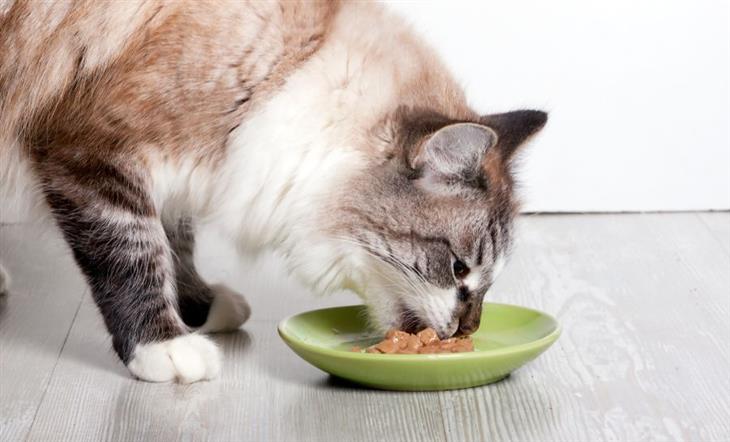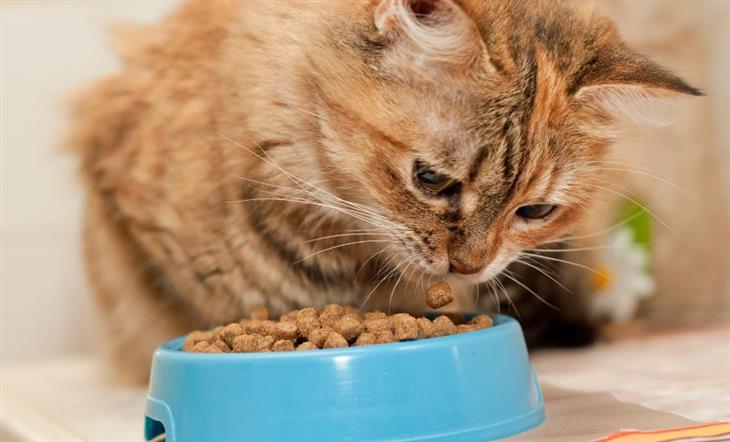Does your feline friend frequently walk back and forth between you and their empty bowl, anticipating a refill? Or maybe they eat whenever they please, regardless of whether they're full or not? However, cat owners should not hastily give in to their pets' pleading eyes when it comes to food, as they have a responsibility to provide their cats with proper nutrition and prevent obesity, which can lead to health issues like diabetes. To help cat owners with this task, we've created a guide on the recommended daily amount and type of food to feed their cats.
How much wet food does my cat need?
Wet food is a crucial aspect of a cat's diet as it is beneficial for their kidney health due to its high liquid content. Cats usually obtain most of their liquid intake from their food in the wild. In comparison to dry food, wet food is of higher quality as it contains fewer carbohydrates and more proteins. It is recommended that an adult cat should consume around 300 grams of wet food daily; however, this amount varies based on factors such as the cat's size, age, weight, and activity level. Additionally, it is crucial to buy high-quality food that contains a high amount of meat to satiate the cat healthily. Opting for quality food reduces the need for constant monitoring of the cat's diet.
The recommended daily intake of wet food for cats is generally 300 grams, but this guideline is mostly applicable to adult cats. The amount of food a cat should receive per day depends on its weight, with different weight ranges having specific gram ranges. However, one should consider other factors such as activity level when determining the amount of food. Active cats may require amounts closer to the upper limit, while lazy cats may require amounts closer to the lower limit.

The recommended daily intake of wet food for cats is generally 300 grams, but this guideline is mostly applicable to adult cats. The amount of food a cat should receive per day depends on its weight, with different weight ranges having specific gram ranges. However, one should consider other factors such as activity level when determining the amount of food. Active cats may require amounts closer to the upper limit, while lazy cats may require amounts closer to the lower limit.
- Below 2 kilos: 120–160 grams
- 2–3 kilos: 210–260 grams
- 4–5 kilos: 240–280 grams
- 6+ kilos: 250–360 grams
If a cat weighs more than the recommended range, it may need to go on a diet, and its food intake should be monitored.
How much dry food does a cat need daily?
Dry cat food is less expensive than wet food and has a high caloric content due to its lack of liquids. However, these disadvantages make it easier for cats to overeat, even if they are consuming the appropriate number of calories or exceeding them. Although there are low-calorie options available, it's essential to understand that they won't significantly improve a cat's health without significant changes to its eating habits.
The packaging of the food you purchased contains instructions from the manufacturer regarding the average caloric requirement for a cat. However, it is important to note that this information should not be taken as an absolute rule. Providing your cat with a varied diet is crucial, and it is recommended to include both dry and wet food in their meals throughout the day. Contrary to popular belief, wet food is more essential for a cat's body as it provides most of the fluids from their food, as in the wild. In terms of quantity, a 2 kg cat should consume 20-40 grams of dry food per day, while a 5 kg cat should consume 60-80 grams per day. It is important to prioritize high-quality wet food over dry food.

How often should a cat be fed?
The frequency of feeding your cat depends on its individual needs and preferences. A cat that lives outdoors sometimes hunts several mice a day if they are around, but it does not eat them all at once, nor does it manage to catch them all. The ones he did catch he saves for different times during the day, and although your domestic cat does not hunt mice, it is possible that he also has such a habit and that he does not empty his bowl when you fill it to the end. However, this is not a sign that he is only eating what he needs. At the same time, some cats are definitely able to finish their entire bowl at once, and they usually throw up afterward - this is also not a good sign.
Your cat can consume at one time a volume of food equal to the body volume of 2–5 mice, depending on its hunger level, but it cannot digest such an amount at once. That's why you have to divide his meals into fixed times, 3 times during the day. For example, don't give a whole can of wet food to the cat, because it's likely that he won't eat it all and everything else will just spoil and go to waste - a shame.
To ensure your cat's dietary needs are met, it's recommended to provide them with small portions of wet and dry food throughout the day. Even if you're away from home for extended periods, an automatic feeding device controlled via an app can be used to dispense food. While these devices are designed for dry food, you can supplement your cat's diet with half portions of wet food in the morning and evening. Alternatively, placing dry food in a toy can simulate hunting behavior and encourage slower eating.


